Freight forwarding services industry highest in terms of number of establishments
The final results of the 2015 Annual Survey of Philippine Business and Industry (ASPBI) showed that a total of 2,680 establishments in the formal sector of the economy were engaged in Transportation and Storage activities.
Among industries, freight forwarding services had the highest number of establishments with 566 or 21.1 percent of the total establishments in the sector. Freight truck operation followed closely with 519 establishments or 19.4 percent. Customs brokerage (ship and aircraft) ranked third with 233 establishments or 8.7 percent. Figure 1 illustrates the percentage distribution of establishments for the sector by industry sub-class in 2015.
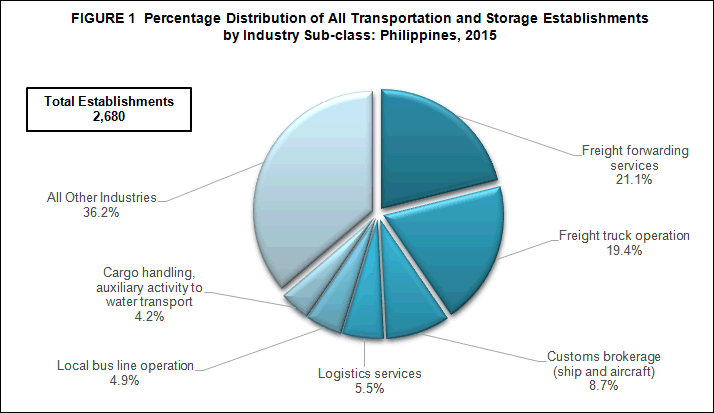
Freight truck operation industry emerges as top employer
In 2015, total employment generated by the sector was recorded at 180,547 workers. Paid employees constituted 178,881 or 99.1 percent and the remaining 1,660 or 0.9 percent were working owners and unpaid workers.
Among industries, freight truck operation had the topmost number of workers with 19,104 or 10.6 percent. Inter-urban bus line operation and freight forwarding services followed closely with 18,747 workers (10.4%) and 17,995 workers (10.0%), respectively. The distribution of employment for the sector by industry sub-class in 2015 is shown in figure 2.
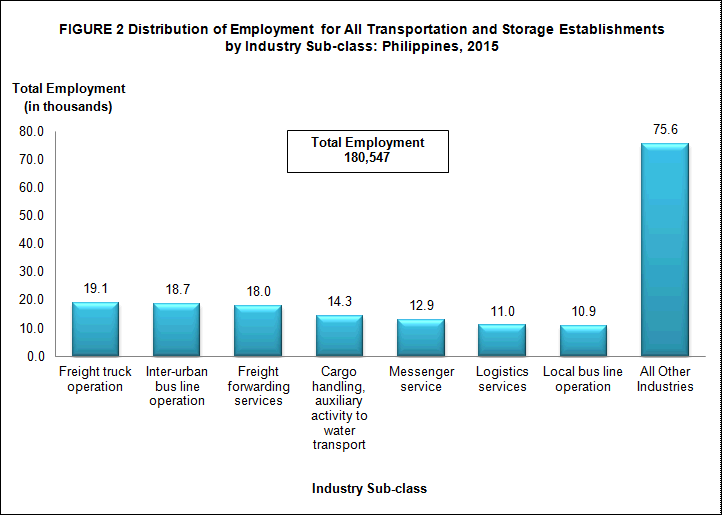
The reported average number of workers per establishment for the sector was 67 employees. Of the 48 industries, 21 exceeded the national average and the top five highest in terms of average number of workers were as follows:
- International air passenger transport, 1,174 workers per establishment
- Inter-urban bus line operation, 293 workers per establishment
- Operation of toll roads and bridges, 278 workers per establishment
- Containerized cargo handling auxiliary activity to land transport, 253 workers per establishment
- Interisland water passenger transport, 155 workers per establishment
International air passenger transport industry pays the highest average annual compensation
The sector paid a total compensation of PHP56.3 billion in 2015, translating to an average annual compensation of PHP315.0 thousand per employee.
By industry sub-class, international air passenger transport industry paid the highest compensation of PHP9.8 billion or 17.4 percent of the total compensation for the sector. Freight forwarding services placed second with PHP5.4 billion or 9.6 percent followed by logistics services with PHP4.5 billion or 8.0 percent.
Establishments under international air passenger transport paid the highest average annual compensation of PHP1,044.4 thousand per employee. This was followed by Inter-urban passenger railway transport and Urban and suburban railway transport with combined average annual compensation of PHP753.0 thousand per employee. Customs bonded warehouses occupied the third post with an average annual compensation of PHP599.9 per employee. Presented in figure 3 is the average annual compensation per employee of the leading industries for the sector in 2015.
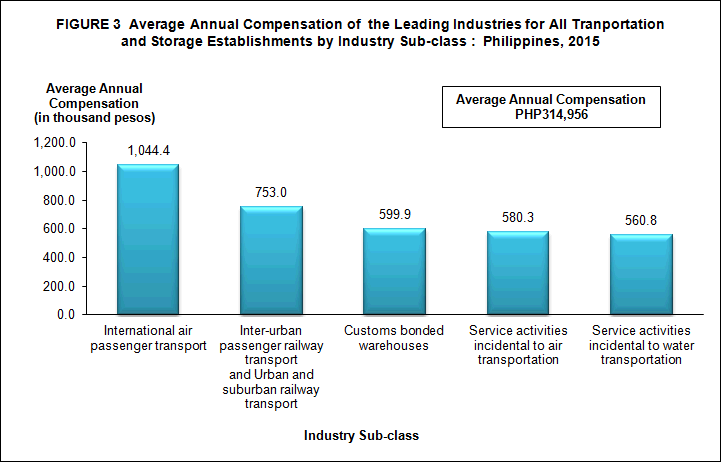
International air passenger transport industry contributes the major share in income and expense
In 2015, total income generated by the sector amounted to PHP591.9 billion. The only industry which generated more than a hundred billion pesos worth of income was international air passenger transport with PHP181.6 billion or 30.7 percent of the total income for the sector.
Other industries with recorded income of more than twenty billion pesos in 2015 were as follows:
- Logistics services, PHP91.0 billion
- Containerized cargo handling, auxiliary activity to land transport, PHP52.0 billion
- Interisland water passenger transport, PHP36.0 billion
- Operation of toll roads and bridges, PHP28.8 billion
- Freight forwarding services, PHP27.3 billion
On the other hand, total expense for the sector in 2015 summed-up to PHP511.2 billion. Among industries, international air passenger transport spent more than a hundred billion worth in expense amounting to PHP169.3 billion or 33.1 percent of the total expense for the sector.
Other industries that incurred more than twenty billion pesos worth in expense in 2015 were the following:
- Logistics services, PHP79.2 billion (15.5%)
- Containerized cargo handling, auxiliary activity to land transport, PHP46.0 billion (9.0%)
- Freight forwarding services, PHP25.4 billion (5.0%)
- Interisland water passenger transport, PHP22.1 billion (4.3%)
The five leading industries for the sector in terms of income and expense in 2015 is shown in figure 4.
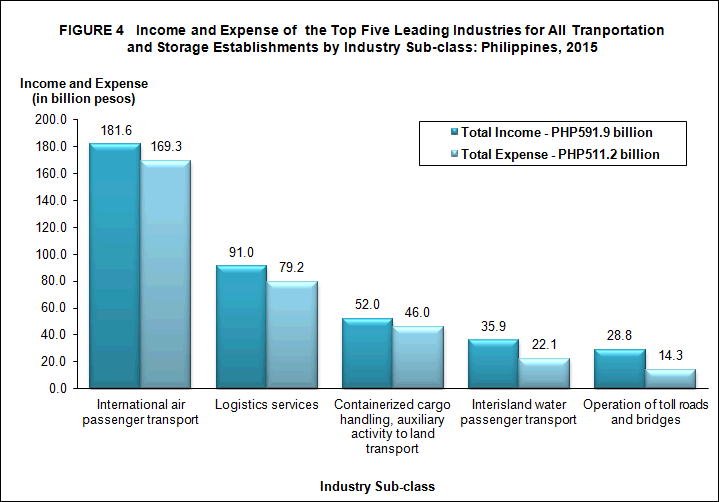
Income-expense ratio stands at 1.16
The income generated per peso expense for Transportation and Storage Sector stood at 1.16. This means that for every peso spent, a corresponding income of PHP1.16 was generated.
Among industries, operation of toll roads and bridges recorded the highest income per expense ratio of 2.01. Of the 48 industries in the sector, 20 or 41.7 percent yielded more than the recorded national average income per expense ratio for the sector.
International air passenger transport industry generates the highest value added in 2015
Value added generated by the sector was estimated at PHP207.3 billion in 2015.
International air passenger transport registered the highest value added of PHP40.9 billion or 19.7 percent of the total value added for the sector. Logistics services recorded PHP29.1 billion or 14.0 percent of the total value added, while, interisland water passenger transport registered PHP20.3 billion worth of value added which is equivalent to 9.8 percent share.
Other industries with more than ten billion pesos in terms of value added were as follows:
- Operation of toll roads and bridges, PHP19.0 billion
- Containerized cargo handling, auxiliary activity to land transport, PHP15.8 billion
- Cargo handling, auxiliary activity to water transport, PHP13.1 billion
- Services activities incidental to water transportation, PHP11.2 billion
Operations of toll roads and bridges industry tops labor productivity
In 2015, labor productivity (value added per total employment), for the sector stood at PHP1.1 million per worker.
Operation of toll roads and bridges was the topmost in terms of labor productivity among industries amounting to PHP6,839.0 thousand per worker. This was followed by containerized cargo handling, auxiliary activity to land transport which registered an amount of PHP5,674.1 thousand per worker. International air passenger transport came in third with labor productivity of PHP4,350.1 thousand per worker. Figure 5 presents the top five industries in terms of labor productivity in 2015.
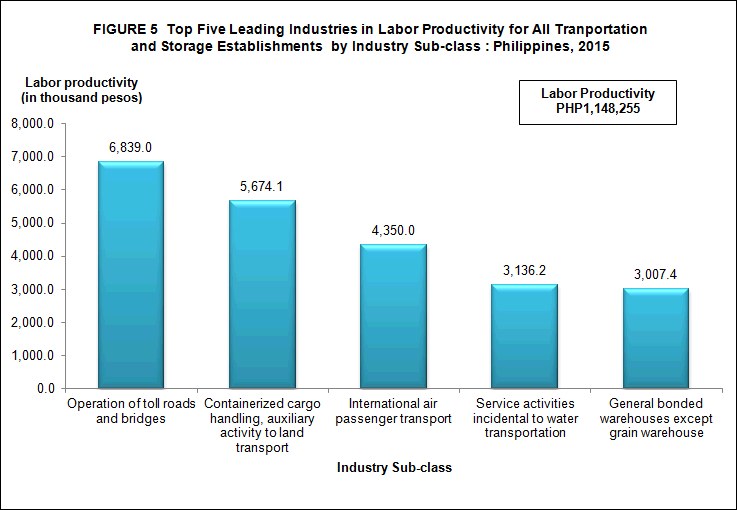
Gross additions to fixed assets reach PHP34.0 billion
In 2015, gross additions to fixed assets (capital expenditures less sale of fixed assets) acquired by the sector was valued at PHP34.0 billion.
Six industries contributed more than PHP1.0 billion worth in gross additions to fixed assets in 2015. International air passenger transport contributed the highest gross additions to fixed assets amounting to PHP11.0 billion (32.5%). Logistics services and interisland water passenger transport followed with PHP8.0 billion (23.5%) and PHP3.5 billion (10.3%) gross additions to fixed assets, respectively.
Inter-urban bus line operation industry records biggest change in inventories
Change in inventories, defined as the value of ending less beginning inventory, reached negative PHP434.4 million in 2015.
The top three industries, which registered positive change in inventories in 2015 were inter-urban bus line operation with PHP204.9 million, freight forwarding services with PHP41.7 million and towing and pushing services on coastal and trans-oceanic waters with PHP40.6 million.
Subsidy received in sums up to PHP9.5 billion
Subsidy received from the government by the sector in 2015 registered a total of PHP9.5 billion. This amount was provided to urban and suburban railway transport and inter-urban passenger railway transport (PHP9.5 billion) and local bus line operation (PHP45.0 thousand).
Sales from e-commerce post PHP31.5 billion
E-commerce sales generated by the sector was PHP31.5 billion or 5.3 percent of the total income in 2015. International air passenger transport reported the biggest sale from e-commerce transactions amounting to PHP28.2 billion. Sales from e-commerce during the year by storage and warehousing, n.e.c. and logistics services reached PHP234.8 million and PHP229.5 million, respectively.
TECHNICAL NOTES
Introduction
This Special Release presents the final results of the 2015 Annual Survey of Philippine Business and Industry (ASPBI) for all Transportation and Storage (Sector H) establishments.
The 2015 ASPBI is one of the designated statistical activities of the Philippine Statistics Authority (PSA). Data collected from the survey provide information on the levels, structure, performance, and trends of economic activities of the formal sector in the entire country for the year 2015. The 2015 Survey of Information and Communications Technology (SICT) was undertaken as a rider to this survey.
The survey was conducted nationwide in 2016 with the year 2015 as the reference period, except for employment where the reference period is November 15, 2015.
Establishment Data Management System (EDMS) was utilized in the decentralized processing of 2015 ASPBI questionnaires in the province as well as the online accomplishment of questionnaire through the PSA website.
Data are presented at the national/regional sub-class or 5-digit 2009 Philippine Standard Industrial Classification (PSIC)..
Legal Authority
The conduct of the 2015 ASPBI is authorized under Republic Act 10625 known as the Philippine Statistical Act of 2013 - Reorganizing and Strengthening of the Philippine Statistical System (PSS), its agencies and instrumentalities.
Scope and Coverage
The 2015 ASPBI covered establishments engaged in 18 economic sectors classified under the 2009 PSIC, namely:
- Agriculture, Forestry and Fishing (A)
- Mining and Quarrying (B)
- Manufacturing (C)
- Electricity, Gas, Steam, and Air Conditioning Supply (D)
- Water Supply; Sewerage, Waste Management and Remediation Activities (E)
- Construction (F)
- Wholesale and Retail Trade; Repair of Motor Vehicles and Motorcycles (G)
- Transportation and Storage (H)
- Accommodation and Food Service Activities (I)
- Information and Communication (J)
- Financial and Insurance Activities (K)
- Real Estate Activities (L)
- Professional, Scientific and Technical Activities (M)
- Administrative and Support Service Activities (N)
- Education (P)
- Human Health and Social Work Activities (Q)
- Arts, Entertainment and Recreation (R)
- Other Service Activities (S)
The survey was confined to the formal sector of the economy, which consists of the following:
- Corporations and partnerships
- Cooperatives and foundations
- Single proprietorship with employment of 10 and over
- Single proprietorship with branches
Hence, the 2015 ASPBI covered only the following economic units:
- All establishments with total employment (TE) of 10 or more, and;
- All establishments with TE of less than 10, except those establishments with Legal Organization = 1 (single proprietorship) and Economic Organization = 1 (single establishment), that are engaged in economic activities classified according to the 2009 Philippine Standard Industrial Classification (PSIC).
Frame of Establishments
The frame for the 2015 ASPBI was extracted from the 2015 List of Establishments (LE). The estimated number of establishments in operation in the country in 2015 totaled to 909,786. About 259,386 establishments (29.0% of the total establishments) belong to the formal sector of which 223,821 (86.3%) comprised the establishment frame. This frame was used to draw the sample establishments for the survey.
Unit of Enumeration
The unit of enumeration for the 2015 ASPBI is the establishment. An establishment is defined as an economic unit under a single ownership or control which engages in one or predominantly one kind of activity at a single fixed location.
Classification of Establishments
An establishment is categorized by its economic organization, legal organization, industrial classification, employment size and geographic location.
Economic Organization refers to the organizational structure or role of the establishment in the organization. An establishment may be single establishment, branch, establishment and main office with branches elsewhere, main office only, and ancillary unit other than main office.
Legal Organization refers to the legal form of the economic entity which owns the establishment. An establishment may be single proprietorship, partnership, government corporation, stock corporation, non-stock corporation, and cooperative.
Industrial Classification of an economic unit was determined by the activity from which it derives its major income or revenue. The 2009 PSIC which was approved for adoption by government agencies and instrumentalities through NSCB Resolution No. 2 Series 2010 was utilized to classify economic units according to their economic activities.
Size of an establishment is determined by its total employment (TE) as of specific date. Total employment (TE) refers to the total number of persons who work in or for the establishment.
This includes paid employees, working owners, unpaid workers and all employees who work full-time or part-time including seasonal workers. Included also are persons on short term leave such as those on sick, vacation or annual leaves and on strike.
Geographic Classification refers to the grouping of establishments by geographic area using the Philippine Standard Geographic Code (PSGC) classification. The PSGC contains the latest updates on the official number of regions, provinces, cities, municipalities, and barangays in the Philippines. The PSGC as of December 31, 2015 was used for the 2015 ASPBI.
Sampling Design
The 2015 ASPBI uses a stratified systematic sampling with 3-digit or 5-digit PSIC serving as industry strata and employment size as the second stratification variable. The selection of sample establishments is done independently by stratum using systematic sampling.
Estimation Procedure for Establishments with TE of Less Than 20
a. Non-Certainty Stratus
The estimate of the total of a characteristic  for the non-certainty employment stratum TE less than 20 in the sth industry domain was
for the non-certainty employment stratum TE less than 20 in the sth industry domain was

where:
s = denotes the non-certainty employment strata in TE of less than 20
Xsj = value of the jth establishment in non-certainty employment stratum in TE of less than 20 in Sth industry domain
j = 1,2,3..., ns establishments
Wsj = weight of the jth establishment in the non-certainty employment stratum of less than 20 in the sth industry domain

Ns = total number of establishments in the non-certainty employment stratum in TE of less than 20 in the sth industry domain
ns = number of sample establishments in the non-certainty employment stratum in TE of less than 20 in sth domain
b. Certainty Stratum
The total of a characteristic  for the certainty employment stratum in the Cth industry domain is
for the certainty employment stratum in the Cth industry domain is

where:
c = denotes the certainty employment strata in TE of less than 20 in the cth industry
xcj = value of the jth establishment in the certainty employment strata in TE of less than 20 in the cth industry domain
j = 1,2,3,..., mc establishments
mc = number of establishments in the certainty employment strata in TE of less than 20 in the cth industry domain
c. Total Estimate for TE of Less Than 20
For all sections except B and C, national level estimates of the total of a characteristic for the industry domain was obtain by aggregating the estimates for all employment strata (non-certainty and certainty) in the same industry domain,
for the industry domain was obtain by aggregating the estimates for all employment strata (non-certainty and certainty) in the same industry domain,

where d denotes the industry domain.
Estimation Procedure for Establishments with TE of 20 and Over
a. Non-Certainty Stratum (strata of TE 20 to 49 and TE 50 to 99)
Sections A,C,E,F,G, H, I, J, K, L, M, N, P, Q, R and S.
The estimate of the total of a characteristic  for the non-certainty employment strata in an industry domain in each region
for the non-certainty employment strata in an industry domain in each region

where:
s = denotes the non-certainty employment strata in TE of 20 to 49 and TE 50 TO 99
p = 1, 2,..., 18 regions (geographic domains)
Xspj = value of the jthestablishment in the non-certainty employment strata with TE of 20 to 49 and TE 50 to 99 for an industry domain in each region
j = 1,2,3,..., nsp establishments
Wspj = weight of the jth establishment in the non-certainty employment strata with TE of 20 to 49 and TE 50 to 99 for an industry domain in each region

Nsp = total number of establishments in the non-certainty employment strata in TE of 20 and over for an industry domain in each region
nsp = number of sample establishments in the non-certainty employment strata in TE of 20 and over for an industry domain in each region
b. Certainty Stratum (Establishments under the following: Section B and D, ICT core industries, BPM industries, GOCC's and with TE 100 and over)
 for the certainty employment stratum in an industry domain in each region
for the certainty employment stratum in an industry domain in each region
where:
c = denotes the certainty employment strata in TE of 20 and over
p = 1,2,...18 regions (geographic domains)
Xcpj = value of the jthestablishment in the non-certainty employment strata in TE of 20 and over for an industry domain in each region
j = 1,2,3,..., mcp establishments
mcp = number of establishments in the certainty employment strata in TE of 20 and over in an industry domain within each region
c. Total Estimate for TE of 20 and Over
The estimate of the total of a characteristic  for the industry domain in each region (geopraphic domain) is obtained by aggregating the estimates for all employment strata (non-certainty and certainty) in the same industry domain,
for the industry domain in each region (geopraphic domain) is obtained by aggregating the estimates for all employment strata (non-certainty and certainty) in the same industry domain,

where d denotes the industry domains and p refers to region.
National level estimates of the characteristics by industry domain are obtained by aggregating separately the estimates  for the particular industry domain from all the regions.
for the particular industry domain from all the regions.
Weight Adjusment Factor for Non-Response
To account for non-response in the non-certainty strata, the adjusment factor (n/n') was multiplied with the sampling weight (W) of each of the sampling unit. The sampling weight, defined as N/n, was recomputed as

Thus, the adjusted weight (W'spj) for the non-certainty employment stratum for the industry domain with TE 20-99 was

Where:
Nsp = total number of establishments in the non-certainty employment stratum with TE 20-99 for the industry domain within each geographic domain (region)
n'sp = number of responding establishments in the non-certainty employment stratum with TE of 20-99 for the industry domain within each geographic domain (region)
Response Rate
Response rate for all sample establishments under Transportation and Storage sector was 94.1 percent (922 out of 980 establishments). This included receipts of "good" questionnaires, partially accomplished questionnaires, reports of closed, moved out or out of scope establishments.
Of the total responses, 19 establishments responded online.
Reports of the remaining non-reporting establishments were taken from other available administrative data sources and financial statements from Securities and Exchange Commission (SEC). However, there were establishments which were found to be duplicates, out-of-scope and out of business in 2015.
Limitation of Data
Only the formal sector was covered in the survey.
Concepts and Definitions of Terms
Establishment is as an economic unit under a single ownership control, i.e., under a single entity, engaged in one or predominantly one kind of economic activity at a single fixed location.
Economic activity is the establishment’s source of income. If the establishment is engaged in several activities, its main economic activity is that which earns the biggest income or revenue.
Total employment is the number of persons who worked in for the establishment as of November 15, 2015.
Paid employees are all persons working in the establishment and receiving pay, as well as those working away from the establishment paid by and under the control of the establishment. Included are all employees on sick leave, paid vacation or holiday. Excluded are consultants, home workers, receiving pure commissions only, and workers on indefinite leave.
Compensation is the sum of salaries and wages, separation/retirement/terminal pay, gratuities, and payments made by the employer in behalf of the employees such as contribution to SSS/GSIS, ECC, PhilHealth, Pag-ibig, etc.
Salaries and wages are payments in cash or in kind to all employees, prior to deductions for employee’s contributions to SSS/GSIS, withholding tax, etc. Included are total basic pay, overtime pay and other benefits.
Income or Revenue refers to cash received and receivables for goods/products and by-products sold and services rendered. Valuation is at producer prices (ex-establishment) net of discounts and allowances, including duties and taxes but excluding subsidies.
E-commerce refers to the selling of products or services over electronic systems such as Internet Protocol-based networks and other computer networks. Electronic Data Interchange (EDI) network, or other on-line system. Excluded are orders received from telephone, facsimile and e-mails.
Expense refers to cost incurred by the establishment during the year whether paid or payable. This is treated on a consumed basis. Valuation is at purchaser price including taxes and other charges, net of rebates, returns and allowances. Goods and services received by the establishment from other establishments of the same enterprise are valued as though purchased.
Value added is gross output less intermediate input. Gross output for Transportation and Storage sector is the sum of the total income (less interest income, rent income from land, dividend income, royalty income and franchise income), capital expenditures of fixed assets produced on own account and change in inventories. Intermediate input is equal to the sum of the following expense items: materials and supplies purchased; fuels, lubricants, oils and greases purchased; electricity purchased, water purchased; industrial services done by others; non-industrial services done by others (less rent expense for land); goods purchased for resale; research and development expense; environmental protection expense; royalty fee; franchise fee; and other expense.
Change in inventories is equivalent to the value of inventories at the end of the year less the value of inventories at the beginning of the year.
Inventories refer to the stock of goods owned by and under the control of the establishment as of a fixed date, regardless of where the stocks are located. Valuation is at current replacement cost in purchaser prices. Replacement cost is the cost of an item in terms of its present price rather than its original cost.
See more at the Transport, Storage and Communications (ASPBI) landing page.
